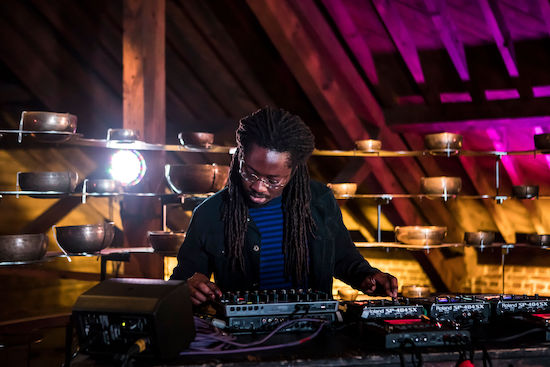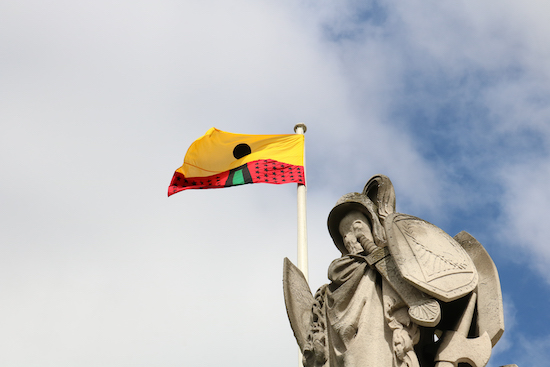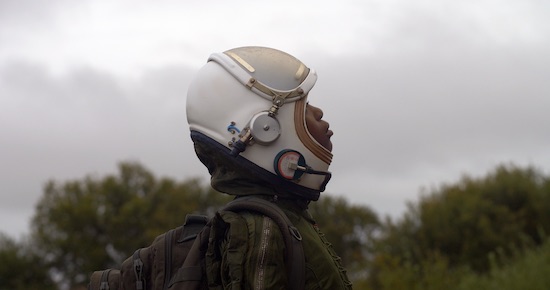How do you make a circle out of squares? Artist Larry Achiampong poses this question to a handful of people atop a creaky lighthouse just east of the Thames. No one seems to know its answer. It’s one of the many esoteric asides that come from his set at Ella Finer’s Longplayer Legacies at Trinity Buoy Wharf, a concert series that considers the legacy and preservation of sound. Achiampong is someone who is uniquely suited for the topic, with his Mogya series a direct result of his own meditations on the legacy and preservation of his Ghanaian heritage, chopping up Highlife music and dusty Hip-Hop beats with the independence speeches of the nations first sovereign leader.
Sound is a medium Achiampong seems most at home with. His audio work is a crucial part of the on-going Relic Traveller – a multidisciplinary project that includes two shorts, a score and an audio-visual performance – where he blends his broad, cinematic electronica with prose that interrogates the ‘architectures of colonialism’. But sampling in particular is his modus operandi. Using AKAI MPC’s he tethers the past to the present and back, considering the cyclical nature of migration in real-time as tracks loop endlessly around each other. Through programmed beats he laments knowledge lost across time and space and revisits the emancipatory possibility of music.
I talk to him after ‘The Voice and The Relic’ at Artsadmin, a presentation of his work including the unreleased Relic 2 and Relic 3, where Achiampong touches upon his constantly changing process in the creation of the Relic Traveller series, the inspiration he finds in family and his kinship with African folklore character Anansi.
You performed at Longplayer Legacies as Slave To The Rhythm where you sampled sounds from video games, videos and vox pops that mentioned concepts like gravity, geometry and mixed it in with music, mainly Hip-Hop. What type of role does sampling play in bringing together your ideas?
LA: I think, to put it bluntly, without sound, so much of my practice won’t exist. I need sound to make certain visuals. If I’m building something physically, having the sound keeping me going has always been an important thing. That’s as far back as me studying art at university level. But I think sound has such a big role to play with telling stories. Reflecting what I said earlier when making these ambitious works, without the sound a lot of it is just pretty visuals and for me there’s so much more than that. There’s nuances and layers that we can apply with sound. With beats for example, knowing that we were gonna be in this visual environment in Jem Finer’s Longplayer installation and seeing it as an opportunity to bring beats that I’ve made and chop them up even further and to make them into minute loops that I play in the looping machines. The smallness and the largeness and the circles and cycles. I don’t think what I do exists without sound.

Larry Achiampong performing at Longplayer Legacies. Photo credit: Debbie Bragg
One of the songs you played had the lyrics, “I have no beginning, I have no end” and was exploring the cyclical, non-linear aspect that sampling has. It’s a type of migration as well, transporting sound across time.
LA: It is. It’s time travelling, these samplers, they are our time travelling machines. They are to us what Marty McFly might do with the Delorean. I just don’t think its been given the chance to be that, maybe we need more time for history to respect that, especially from a musical point of view because I do meet composers who ask “what is the stuff you actually compose?” – well it’s all the fucking same thing. You’re just using a different paintbrush.
Something that comes out in your work is your Ghanaian heritage, as is the Ashanti tradition of Sankofa, “to go and get back”, how important for you as an artist and a child of the diaspora to go back, to use the past to build the future?
LA: Speaking for me it’s very central. I’m somebody who was born and raised in the UK, but I was raised in a Ghanaian household. My mum taught me how to speak Twi, to be bilingual, to have that language that connects with my roots. It’s such a big deal, especially when we’re talking about atmospheres like schools where we don’t have the privilege of having a history painted for us. Or at best get taught a history which is complete bullshit in relation to our truth. Whether it’s with Relic Traveller or with Meh Mogya or whatever the future holds, going back is always an important thing. I feel like a future can’t be seen without looking at what happened before because everything is very cyclic. There’s this thing with modernism that I hate, where you are just shedding and stripping yourself in order to be the future, but the future isn’t anything without that foundation. So that’s a constant in my mind, and that’s a constant thing I try to reimagine. With Relic Traveller it’s much more speculative perhaps, in comparison to Meh Mogya which is much more of a biographical story. There are truths in both things but there are elements of fictioning in Relic Traveller.
Fictioning and myth and symbolism is a big part of Ashanti culture – Anansi, Asantehene, Golden Stool – how important is mythmaking for you as a person living in the diaspora?
LA: Such a big deal. As a kid, my mum used to tell me stories of the Ashanti rebellion against the British, the Asantewaa. We used to have these two frames, one that had Kwame Nkrumah and one that had Yaa Asantewaa and she always used to tell me – almost like a bedtime story or a lullaby – the story of Yaa Asantewaa cutting off the head of a British general and holding them up. And of course maybe there are elements of truth to it, or maybe there aren’t but she told me this story and I was hearing this and then going to school being told through history lessons why the slave trade benefited loads of people.So mythmaking or telling stories is the backbone to everything, even when I’m creating a small project, the element of myth is such a big deal.
I love the Demi-God Anansi for example, that ability of shapeshifting. Most people especially from a western point of view know Anansi as just a spider, but Anansi is the shapeshifter, the spider just happens to lend itself to particular folklore. So I like to always imagine a position similar to that of Anansi’s in painting. Opening up different situations, different moments and then kind of pulling the rug under the table and moving onto something else. Like with the beats, then all of a sudden there’s the video or the photography. It’s like ‘catch me if you can’. I get bored doing one thing, and I think there’s more than one way to tell a story. And I devote myself to all of these things, I’ve spent time and continue to spend time honing and making my beats, pulling the audio in the MPC and the same with filmmaking. In some aspects I was taught formally, in some aspects I wasn’t. But I’m a constant student and with that I wanna throw up different possibilities with the elements I have.
Was studying in predominantly white spaces something that impacted how you present your art? You’re audio work with the Mogya series and performance at Longplayer Legacies were designed so that they can be accessed and experienced anywhere. (Mogya is available digitally and on vinyl, and your Longplayer Legacies performance only requires a set of DJ decks.)
LA: [Laughs] I came up with this term I don’t even use anymore, but at the time it felt like we were all becoming fixtures for mantlepieces. That you’re becoming a ‘mantlepiece artist’. A little thing that just hangs up on a wall and that’s it. [he plays flippantly with some of the programmes illustrating his point] Not to say people can’t do that and do it effectively and do it well. But striving to be in that space or area of existence is dangerous. I learnt that very quickly through studying at art school, being in those spaces. And as I rose through the echelons, there were more white people, there were more people who were middle, upper class and me from a working class background. I’d be meeting fewer people with the language or colloquialism I tend to use, having grown up in Bethnal Green. I learnt more and more that what I was making was not gonna be connecting with some of the people i grew up with but why is that?
That compelled me to make Meh Mogya, I had that idea around 2009 or 2010, I travelled to the US for the first time and was there for 2 to 3 months, it was my own personal residency. I didn’t go as a result of an artistic invitation or whatever, I wanted to go to the birthplace of Hip-Hop, I wanted to go there on my own terms. I wanted to walk. And I walked loads, I went to places, happened upon places, met people, people who I’m still talking to now, some people who for me, changed my perspective on things, all the while listening to things like Nas – Illmatic. Ain’t no fucking art course gonna teach you that shit. They ain’t gonna teach you that, and I came back to the UK knowing that there’s something with sound that hasn’t been done, that needs to happen and I’ll be sure to reference the likes of J Dilla or Madlib when doing it.
It’s weird really, so many of these white spaces, didn’t teach me anything about how I can do what I did, if anything they taught me the opposite, that I’m not allowed to, that I can’t do this or I shouldn’t do that, or “you’re not a filmmaker, you didn’t go to filmmaking school, what the fuck do you know about using a gimbal” or “you haven’t shot with a Super 8 for long enough”. Do you know what I mean? Just stupid nonsense like that. I think that’s what those experiences gave me and I’m bit of a stubborn person anyway, so if you tell me I can’t do something then I’m not gonna try and prove it to you that I can do it, I’ll just keep quiet get the work done, and you’ll see it later on.

Pan-African Flag for the Relic Travellers Alliance at Somerset House
Afrofuturist imagery is a large part of your work in Relic 0 and Relic 1, as well as the Pan African Flag for Relic Traveller that you had flying above Somerset House for six months. What do you feel is the responsibility of artists of colour to reclaim spaces like that, is it even something they should have to feel responsible for?
LA: Well from person to person it’s different, who am I to say what the next artist of colour or black artist should be doing? I do give advice to people who are family to me and I can only advise them in the best way I know how personally. But for me, yeah there is massive responsibility. It’s not simply just from that or me being a parent, but I’ll get an email from a young artist asking advice about something, and I really have a responsibility there when shaping my answer. Even if I feel negatively about something, how do I give them the best push? Because when I think of the likes of Yinka Shonibare, Faisal Abdu’allah, Keith Piper, Sonia Boyce, they’re a range of artists who have been mentors to me whether directly or indirectly, so I’m in a position of responsibility whether I like it or not, because of this burden of representation. Sometimes we mess up, we make the wrong decision but things like being on the Board of Trustees at INIVA (Institute of International Visual Art), to me that’s a position of responsibility. If I’m coming to do a talk and I talk about aspects of the black experience or the experience of oppressed people, I’m in a position of responsibility, you gotta come through or you don’t at all. But that’s different from person to person, you’ll probably ask another artist who’ll just do their own thing and that’s alright thats for them, but this is how I see it.
So much of your work, Mogya tapes, Relic Traveller picks up on the interplay between nationhood and identity, is your identity something that you feel you need to negotiate? Almost find a middle point between being British and being Ghanaian?
LA: I don’t think I need to negotiate shit. People make their minds up about us once we enter spaces and I can’t control what people think, but I do have a space where I can say what I think and that’s what I’m interested, as far as my identity goes. Again I grew up in a household where I was taught to speak Twi, within an environment that was British. But I don’t know what being British really means, because I’ve never felt entirely welcome. I’m not saying that I haven’t been to Ghana and the people haven’t said “obroni” (white man in Ghanaian language Twi). There are some people who may feel more alienated but for me that shit just melts off. It fucking melts off, like what do you know, you’re fucking praying to a White Jesus still [we both laugh]. So I’m not fighting for someone to accept me. What I am trying to fight for in my own way, is for stories that need to be told or represented and why can’t we have a good time whilst we’re doing it?
I’m more of a Londoner than I am British. I can tell you what being from East London is, I can tell you what hanging out in Mile End or Roman Road is like and what that means. Of course I feel closer to that which I originate from [Ghana] because there’s more of an open access for me. After my parents settling here, there’s no one in my family who really did set up here, there are other people who are 4, 5, 6 generations, for me it’s perhaps a bit more clear. Maybe the answer would be different if I was 7th generation, maybe it wouldn’t be different but that’s certainly how I feel. I’m just not interested in hearing what other people have to say, because they are always gonna label you as this or that. Well, good on you if that what helps you sell your product, but I think for the people that know, for the people that stay there after all the lights turn off, they know. You know?
Larry Achiampong, Relic Traveller – Sankofa, is at Eastside Projects, Birmingham, until 1 December


